
Domov | O Zborniku | 10 let društva | SDUTSJ

Inter Alia 1
ISBN: 978-
ISSN:
Mojca Šauperl
Abstracts in History: Content and Linguistic Features
ABSTRACT
The abstract is the text which Slovene historians most frequently have to write in English. Writing an abstract is a very complex task, yet ISO: 214:1976, academic writing manuals and history journals provide authors with insufficient guidelines. In this paper content of history abstracts as identified by Helen Tibbo (1993) is compared to the findings of Caroline Coffin (2006). An analysis of 100 abstracts from 4 history journals confirms the presence of the linguistic features which Coffin found in historical texts. The corpus analysis shows that causality is most frequently expressed by nominal groups and verbs and that metatextual verbs are the most salient feature of these abstracts. In the conclusion, Tibbo and Coffin's findings are determined to be useful tools in designing the content of the abstract, while the corpus analysis suggests a list of linguistic items to be taught before or during the process of teaching the writing of abstracts in an English course for undergraduate history students.
Keywords: abstract, history, English for specialist purposes, content, corpus analysis, metatextual verbs.
1. Introduction
The abstract is the text which Slovene historians most frequently have to write in English. Even if they publish their articles in a Slovene journal and the language of the article is Slovene, the accompanying abstract is in a foreign language, usually English. Thus a need to include abstract writing into the ESP syllabus for undergraduate history students has been expressed by both the faculty and the students at the University of Primorska.
But writing an abstract seems an extremely complex, even gravid, task: this short text should faithfully represent the article while also skillfully promoting it. Such a task requires good command of language, in this case English, and good writing skills. The analysis, reported on here, aims at identifying the structure of the abstract’s content and its linguistic characteristics, hoping that the findings may be employed in the drafting of a module on abstract writing at an advanced ESP level.
The ISO definition of the abstract is “an abbreviated, accurate representation of the contents of a document, without added interpretation or criticism and without distinction as to who wrote the abstract” (ISO: 214:1976, confirmed on 23 August 2004, p. 1, hereafter Standard). The Standard’s guidelines structure the abstract’s content into: purpose, method, results and conclusions. The Standard allows the inclusion of additional information if there is enough space. But both the Standard and academic writing manuals, which at best seem to reiterate the former, ignore the specific demands of the academic field. It is this flaw that Helen Tibbo (1993) addresses when she argues that such a structure of the abstract’s content is of little use to historians and proposes an alternative set of guidelines.
This article reports on one part of a pilot study carried out by Dr. Alenka Šauperl of the University of Ljubljana’s Faculty of Arts and myself. A. Šauperl analysed the selected 100 abstracts in history journals from the information science point of view (for a similar analysis see Šauperl, 2008), while I analysed their linguistic features.
This article will briefly summarize Helen Tibbo’s (1993) guidelines and compare them to the findings of Caroline Coffin (2006), who analyzed the content and language of historical genres. A report on the findings of a linguistic analysis of a corpus comprising 100 historical abstracts will follow, focusing on two main features, causality and the use of metatextual verbs. Finally, a set of issues to be dealt with in ESP before writing abstracts will be proposed.
2. Method
In order to collect 100 abstracts from history journals published in the English language, a selection of those journals which are accessible in the Slovene academic libraries in electronic form, and are recognized both in Slovenia and internationally, was first made. None of these journals publishes any instructions on how to write an abstract on their websites, although some do suggest a word limit. It is presumed that some journals may provide their authors with some guidelines that seem to change periodically, resulting in significant heterogeneity in abstracts from different issues. Eventually, 4 journals were selected, each to provide 25 more or less homogeneous abstracts. These journals were:
– History & Memory. Frankfurt am Mein: Athenaum, 1989-
– History. Oxford: Blackwell, 1912-
– American Historical Review. Washington: American Historical Association, 1896-
– European History Quarterly. London: Sage Publications, 1984-
The corpus was collected in September 2007, so any later issues of these journals were not taken into account. This article only reports on the linguistic analysis, which was carried out by using the AntConc 3. 2. 1w (Windows) 2007 concordancer. This analysis sought to verify whether the findings of Caroline Coffin could be extended to abstracts.
It should be pointed out that the present corpus of 100 abstracts is limited, amounting to only 12,697 words. The present analysis is therefore projected as a pilot study and will be repeated with a larger corpus.
3. The Content of the Historical Abstract
3.1 Tibbo’s Content Structure
Tibbo (1993) argues that the content elements as suggested by ISO: 214:1976 are not
present in abstracts in history, concluding that they are inadequate to the subject
of history. She therefore proposes a different set of content elements. Tibbo (ibid.,
pp. 191-
· Specific dates of key events and/or the period covered by the text
· Colligatory time span indicators (e.g., the Renaissance)
· Names of key geo-
· Names of key individuals and/or groups
· Names of key institutions and/or organizations
· Names of key events
· Other topical terms that do not fit into one of the above categories but are central to the text.
However, Tibbo (ibid., p. 192) demonstrates that other significant information is often included in abstracts. These data regard:
· Historical context as necessary to make the remainder of the content understandable.
· Historiographical and/or scholarly context (i.e., interpretative stance and the work’s place in any existing scholarly arguments)
· Purpose and scope of study including mention of the key time periods, geo-
· Summary of the author’s main theses, arguments, opinions, explanations, and conclusions.
· Description of the author’s methodology, especially if it involves other than archival work.
· Specific identification of key data sources that the author used in the writing of the document
· If the text documents a social scientific work, a list of important empirical results
· “Type” of history designations (e.g., social, military, medieval)
3.2 Coffin’s Content Structure
Tibbo’s content structure, particularly the placement into historical and historiographical context and the summary of the author’s main theses, etc., recalls the content elements that Caroline Coffin (2006) identifies in historical texts. Coffin determines 9 basic historical genres: 4 recording genres (the autobiography, biography, historical recount and historical account), 2 explanatory genres (the factorial and consequential explanation), and 3 argumentative genres (the exposition, discussion and challenge). Historical texts need not be pure representatives of any one genre, but are indeed most often composed of passages belonging to various genres. An article may thus contain a paragraph or passage, which is a biography, another passage being a historical recount, etc.
It is presumed that articles published in academic journals can be classified within the argumentative genre. These articles’ abstracts are supposed to faithfully represent the articles’ content. It is therefore expected that they will retain some trace of the content structure of the original texts. For this reason, a summary of Coffin’s (2006) content elements might be useful. These are:
1. In the recording genres:
· Background or orientation
· Record of events
· Deduction or evaluation of historical significance
2. In the explanatory genres:
a) The factorial explanation
· Outcome
· Series of factors
· Reinforcement of factors
b) The consequential explanation
· Input
· Series of consequences
· Reinforcement of consequences
3. In the argumentative genres:
a) The exposition
· Background (optional)
· Thesis
· Arguments supporting thesis (with possible concessions)
· Reinforcement of thesis
b) The discussion
· Background (optional)
· Issue
· Series of perspectives
· Position
c) The challenge
· Position challenged
· Rebuttal arguments
· Antithesis
An important feature of argumentative genres is the demand for the author’s statement
of his/her position, an opportunity for the author’s self-
3.3 Content analysis of a sample abstract according to Tibbo and Coffin
Below is a randomly chosen sample abstract, in which the sentences have been numbered for easier orientation:
1Central to the Peterloo Massacre in 1819 was the high public profile of working-
At least 6, if not 8 out of 15 Tibbo’s (1993) content elements can be identified
in the above abstract: 1. specific date, 2. key group (women, army – implied in military
attack), 3. name of event (the Peterloo Massacre), 3. other topical terms (Radical
Reform programme, feminism, British politics, vote, white dress, brutal attack, etc.),
4. historical context (sentence 1), 5. summary of the author’s main thesis and arguments
(sentence 6), 6. name of a geo-
The first two sentences constitute the background/orientation and description of the historical event. Sentence 4 is both a narration of events and a thesis. Sentence 5 brings forward a challenging and innovative thesis, which does not insist on the reader’s alignment (note the use of arguably). The last sentence (6) gives the final thesis, evaluating the historical significance of the event, which according to Coffin (2006) is a frequent conclusion of historical texts. This final stage is of key importance: if the author succeeds in proving that the matter is historically significant (and his/her approach original), then he/she has secured the relevance of the research question, thus legitimizing the research. Coffin does not mention “author’s purpose;” however, it often seems to be implied in the formulation of the thesis. The sample abstract is one of the few abstracts in the corpus where the author explicitly states his purpose (sentence 3).
A mention of methodology is absent from the sample abstract, as it is from most of
the abstracts in the corpus. It is presumed that method, purpose and background are
frequently left out due to the author’s expectation that the reader will know the
missing answers, because they are either part of a common base of the discipline
or its epistemology, or are implicit in the policy of the journal. Authors might
resort to the omission of such data because the editing board limits the length of
the abstracts. A skilful author will thus select the data he/she deems less self-
4. The Linguistic Analysis of the Abstracts
According to Coffin (2006) argumentative texts are characterized by several linguistic features. Among these, four are potentially interesting for ESP. These are:
· Nominalization and long nominal groups
· Modality
· Conjunctive adverbs for the textual organization of arguments and perspectives
· Causal relationships, rendered with a wide range of lexicogrammatical elements (mostly nouns, verbs, adverbs and conjunctions).
· Verbs of saying/thinking
The analysis reported on here has identified all of these traits of the argumentative genre. The selected abstracts are dense with nouns and nominal groups, and the level of causality is very high. Modality and conjunctive adverbs (first, second, etc.) are evident but not salient.
Coffin (2006) argues that verbs of saying/thinking are an important device adopted by an author in interaction with other voices (other authors which he quotes or rebuts) or the reader. This group of verbs somehow coincides with the verbs to which Fløttum et al. (2006) refer as metatextual verbs. These verbs are the most salient feature of the examined abstracts.
The range of causal expressions and the use of the metatextual verbs will now be examined.
4.1 Cause and Consequence
This analysis does not consider devices for cause and consequence separately. Neither does it follow Coffin’s (2006) classification of different types of causation.
It should be noted that causation is related to nominalization. According to Coffin (2006), the cause in complex historical texts tends to be expressed by nominal groups. This is confirmed by the present corpus analysis. The most frequent headwords of these nominal groups are: factor (11 occurrences), influence (10 occurrences), reason (6 occurrences), effect (6 occurrences), result, implication and consequence (all three with 4 occurrences). Only the nouns occurring at least twice were counted. 54 occurrences of nouns denoting cause/consequence were found in the 100 abstracts. It is noteworthy that factor(s) collocates with verbs contribute and lead to, both of which will be returned to in section 4.2.
That the cause or consequence of an action or event can be expressed by a nominal phrase (even if no specific cause/consequence noun is used) is evident from the concordances of the verbs which will hereon be referred to as causal verbs. The most frequent among these verbs are lead to (10 occurrences), influence and the causal make (make + direct object + nominal phrase/adjective etc.) (both verbs 5 occurrences). Other similar verbs are: allow, contribute to, result in/from, arise from, emerge from, etc. A total of 38 verbs of this type were found.
Only 10 adverbs denoting cause or consequence were found. The most frequent among these is thus, occurring 6 times. As a result and consequently occur twice each.
Prepositional phrases denoting cause are rare: there are 3 occurrences of in order to, while because of, due to and as a result of occur once each.
Another rare device in expressing causality are conjunctions: in 100 abstracts there are only 3 occurrences of because, while since occurs twice and as only once. However, there are 4 occurrences of if, a conjunction classified by Coffin among the conjunctions denoting the determining causation, which will be returned to later. The most common conjunctions are and and but. Yet while is also noteworthy, with 18 occurrences, of which 14 are used to link two contrasting interpretations, events, etc. Although occurs 8 times and before (as a temporal conjunction) 4 times. Relative pronouns are also quite common.
Coffin (2006) distinguishes between determining causation (i.e., why something happened) and enabling causation (i.e., how something happened). Verbs are just one lexical tool for expressing these two types of causality. Verbs such as result in, create, lead to and determine are typical of determining causation, while verbs such as enable, influence and allow are used for enabling causation. An evident trait of enabling causation is that it is often expressed with manner; e.g., phrases with by and through. The latter occurs 9 times. However, by with a present participle occurs 25 times.
Regarding determining and enabling causation, a look at how and why also reveals interesting statistics. A combination of how and why (or why and how) occurs 4 times. But an independent how is used 18 times, while an independent why only occurs 3 times.
4.2 Metatextual Verbs
Collocation like this article explores is the most salient feature of the corpus. This article occurs 50 times and the (+ adjective) article 45 times. Moreover, there are numerous alternatives for article, such as analysis, essay, etc., and the pronoun it. 168 cases of collocations of such a noun or pronoun with a metatextual verb were found, amounting to an average of 1.7 per abstract. In this study it has not always been possible to keep track of all the present participles of metatextual verbs, which might also be governed by nouns such as article.
Most abstracts are packed with similar collocations. Below is a sample abstract, showing the distribution of similar collocations.
While a good deal has been written about the contacts between British and continental
reformers in 1848 and afterwards, the same cannot be said of the 1820s and 1830s.
This article will investigate the involvement in European affairs of Thomas Perronet
Thompson and John Bowring, two of the closest colleagues of the utilitarian philosopher
Jeremy Bentham. This article has three main purposes: first, to establish the relevance
to British radicalism of a European perspective, using Thompson and Bowring as exemplars
who can be taken to represent one of the most important strands in the British radicalism
of their day; secondly, to improve our understanding of reform agitation and ideologies
in early nineteenth-
Metatextual verbs such as investigate, establish, focus, etc. may express the author's
intervention in the discourse. Fløttum et al. (2006) distinguish between researcher's,
writer's (further subdivided into discourse-
The present study only focused on the use of such verbs when the agent is article
or its alternative, although it should be noted that metatextual verbs can also be
used when talking about other authors' or the reader’s interpretations. Tables 1-
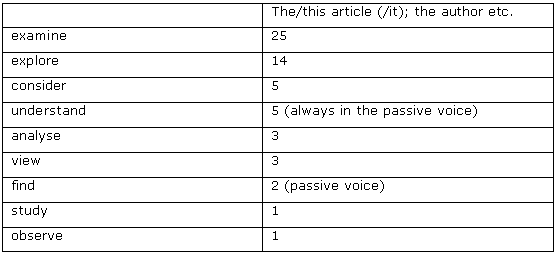
Table 1: Researcher's verbs.
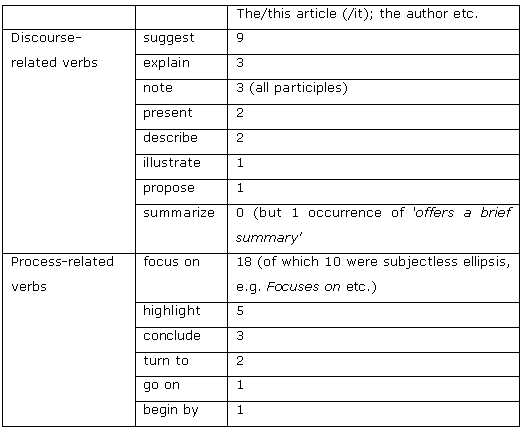
Table 2: Writer's verbs.
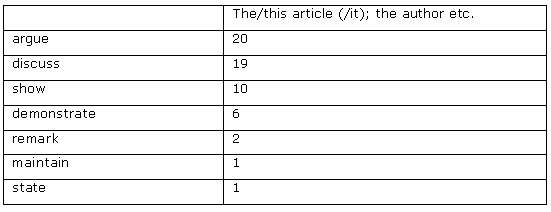
Table 3: Arguer's verbs.
Evaluator's verbs (e.g., feel, be content to) were not found in the selected corpus.
Fløttum et al. studied academic articles in medicine, economics and linguistics. Caution should therefore be taken in comparing their findings to the results of this corpus analysis. It nevertheless needs to be mentioned that Fløttum et al. show that researcher's verbs are the most frequent metatextual verbs, followed by writer's and arguer's verbs, while evaluator's verbs are the rarest. However, the analysis of 100 historical abstracts shows that the writer role is only slightly rarer than the equally common roles of researcher and arguer (Table 4).
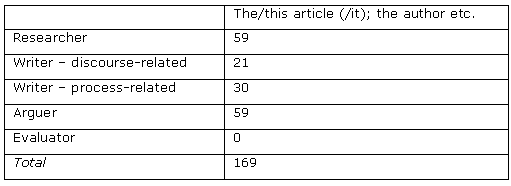
Table 4: Metatextual verbs in the corpus of historical abstracts.
The use of these verbs probably enables the author to reach several objectives:
1. Impersonal style,
2. Transparency of discourse,
3. Organisation of the text.
Impersonal style and 3rd person is typical of abstract writing (Cf.: Graetz, 1985, as cited in Swales, 2000). Nouns such as article, analysis, essay, etc., therefore seem convenient shields for the author, which is evident from the fact that they collocate with metatextual verbs. On the other hand, authors might use this device when distancing themselves from the article in an attempt to take the article itself as the subject of their critical scrutiny. Considering that the abstract describes a text, i.e. the article – as is also noted by Swales (2000) – metatextual devices are an essential tool in the representation of the relationship between the article and its abstract.
Metatextual verbs can also be an effective tool for an author who wishes to analyze and represent his/her own discourse by showing his/her attitude and approach to the subject, his/her process and method of research and writing, and last but not least his/her attitude to alternative interpretations. At the same time, the author interacts with the reader and anticipates the latter's alignment or dissent. Table 5 shows an example of the effective use of metatextual verbs.
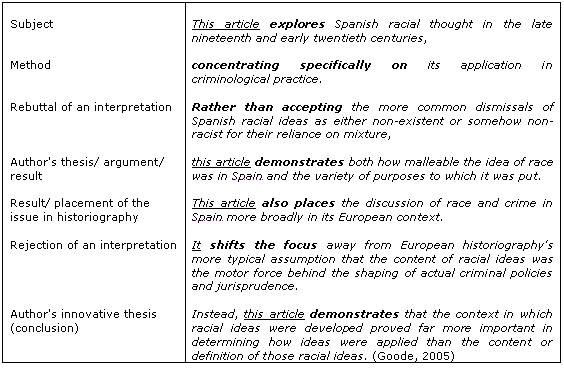
Table 5: Coincidence of content elements with the use of metatextual verbs.
Another very important function of metatextual verbs is therir role in the organization
of the text. A high level of nominalisation requires verbs to function as connectors
between these nominal chunks. Apart from be and have, metatextual verbs are the most
frequent verbs in the corpus. Examine, argue and focus are even more frequent than
can and do. The most frequent lexical verb which is not a metatextual verb -
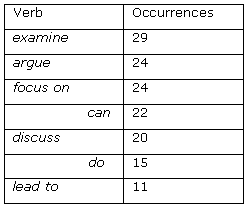
Table 6: The most frequent verbs.
From an information science point of view, metatextual verbs when employed for mere text organization are useless. Chunks like 'This article explores' or 'This article focuses on' have little information value, which is also evident from the fact that the subject 'This article' in the beginning of the abstract is left out 16 times. In some journals examined before collecting the corpus, 'Focuses on' at the beginning of the abstract seemed to be a norm, although it seems surprising that the apparently equally empty initial “Focuses on” is kept. The rest of such an abstract typically shows a high degree of nominalisation. In spite of the fact that this abstract pattern emerges in many journals in limited spans of time it appears eventually to give way to less terse abstracts.
5. Conclusion
Both Helen Tibbo’s (1993) and Caroline Coffin’s (2006) findings seem helpful in teaching the writing of abstracts. If Tibbo’s guidelines constitute a useful checklist, Coffin’s identification of text phases can be employed in the study of sample abstracts and in the phase of an author’s (or in this case, a student’s) analysis of his/her own article, facilitating both a better article structure and a truer representation of the original text by the abstract. The awareness of Tibbo’s content elements and Coffin’s text phases could be developed through both reading and writing activities.
To be able to express causal relationships, authors of historical abstracts written in English need to learn the following:
-
-
-
Aiming at covering the above issues and seeking to develop a good lexical and syntactical
knowledge in students, an ESP teacher of undergraduate history students may pay considerable
attention to word-
The metatextual verbs are probably a more difficult subject and would therefore best be dealt with in the third year of the ESP course. To be able to effectively use metatexutal verbs, writers of abstracts need to understand both their meanings and their syntactic use. The classification into the researcher, writer and arguer role is probably helpful in the process of learning both the metatextual verbs and writing the abstract. Given the wide range and subtle differences in meaning of metatextual verbs, however, the lexical side of these verbs might provide the most critical aspect for the students to master. Reading and writing activities and dictionary work are probably essential here.
It seems then that some of the skills required for the effective writing of abstracts
in history should be a red thread developed throughout the three-
Bibliography
References
Coffin, C. (2006). Historical Discourse : The Language of Time, Cause and Evaluation. London : Continuum.
Fløttum, K., Kinn, T. in Dahl, T. (2006). “We Now Report on …” Versus “Let us Now See how …”. Author Roles and Interaction with Readers in Research Articles. Retrieved 18 November 2007 from http://www.hf.uib.no/forskerskole/FlottumKinnDahl.pdf.
ISO 214: 1976. Documentation -
Šauperl, A., Klasinc, J., Lužar, S. (2008). Components of abstracts: Logical structure of scholarly abstracts in pharmacology, sociology, and linguistics and literature. Journal of the American Society for Information Science and Technology. Vol. 59, issue 9. Published online: May 8 2008. DOI: 10.1002/asi.20858
Swales, J. M. (2000). Genre Analysis. English in Academic and Research Settings. Cambridge : Cambridge University Press.
Tibbo, H. R. (1993). Abstracting, Information Retrieval, and the Humanities: Providing Access to Historical Literature. Chicago, London: American Library Association.
Quoted abstracts
Bush, M. L. (2004). The Women at Peterloo: The Impact of Female Reform on the Manchester
Meeting of 16 August 1819. History; Vol. 89, issue 294, pp. 209-
Goode, J. (2005). Corrupting a Good Mix: Race and Crime in Late Nineteenth-
Turner, M.J. (2005). Arraying Minds against Bodies': Benthamite Radicals and Revolutionary
Europe during the 1820s and 1830s. History, Vol. 90, issue 298, pp. 236-
(CC) SDUTSJ 2008. Zbirka Inter Alia je objavljena pod licenco Creative Commons
Priznanje avtorstva-